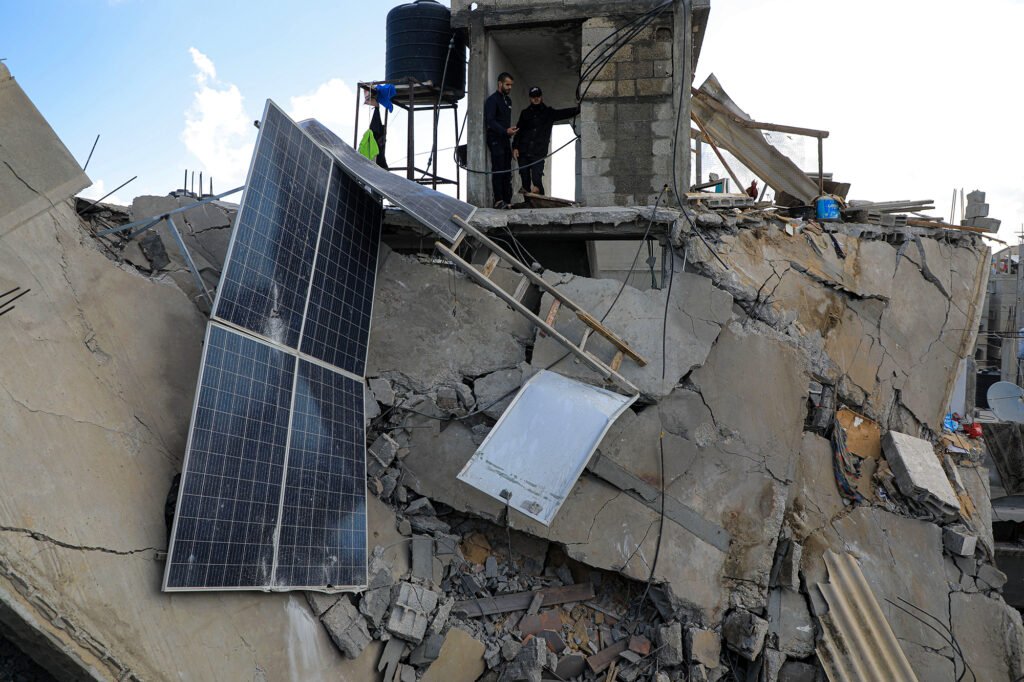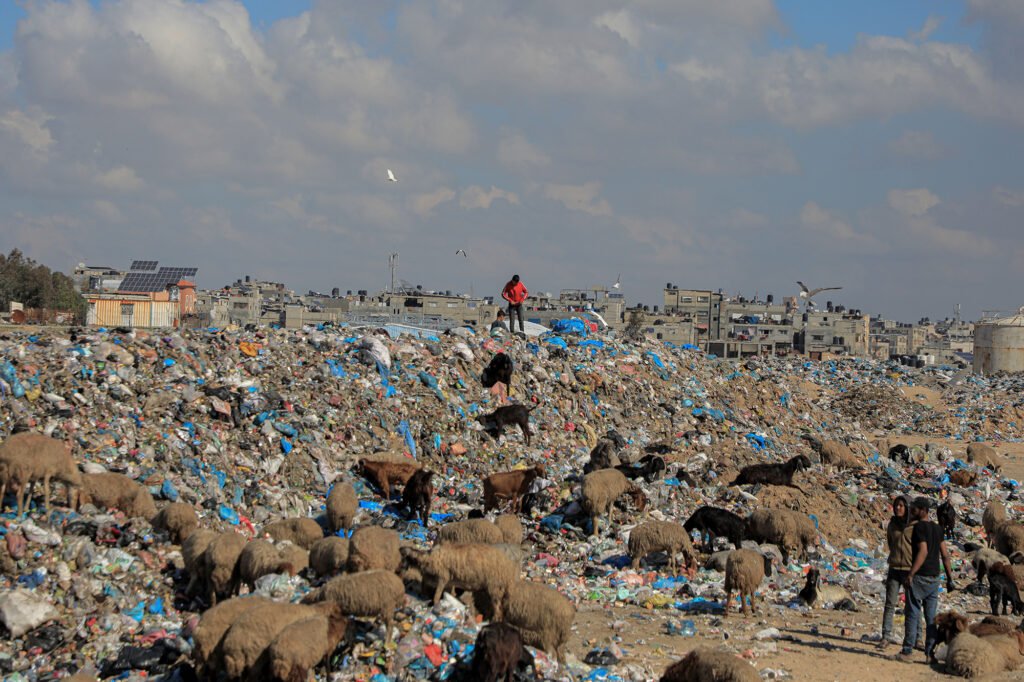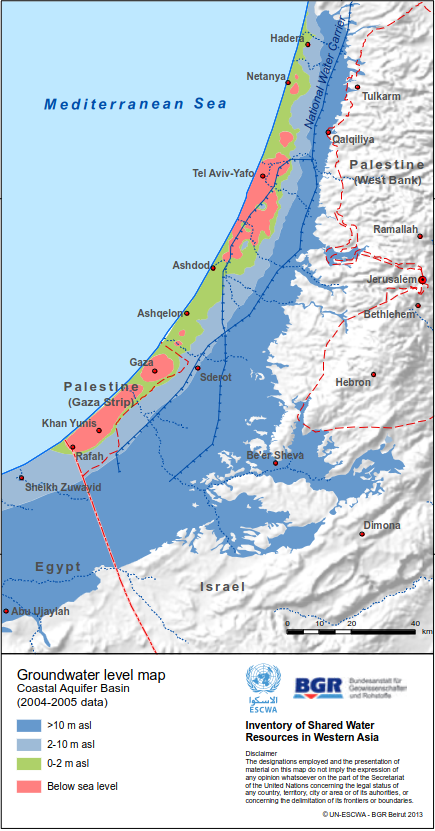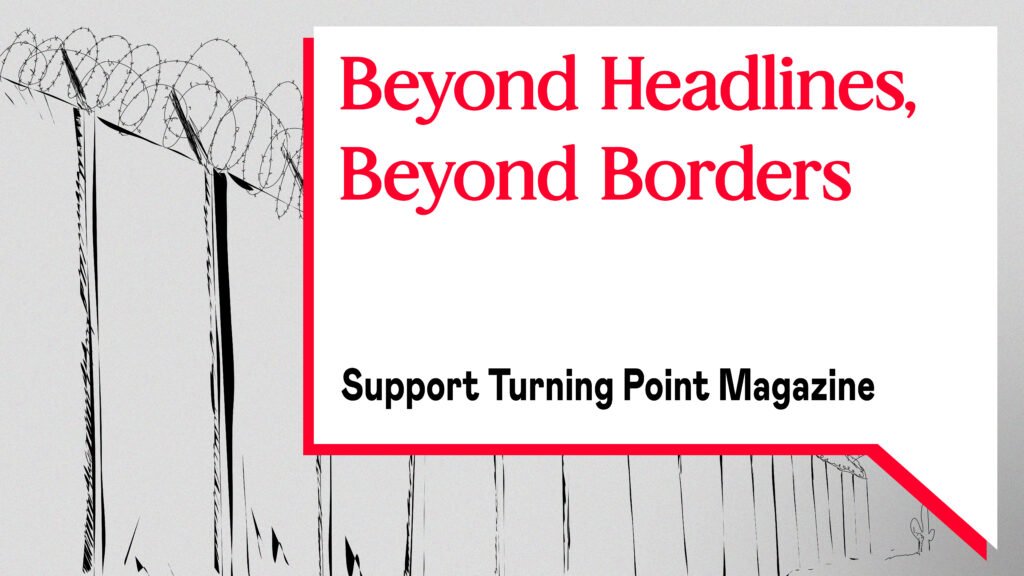Cover photo: June 30, 2024. Pedestrians cross ponds of wastewater in the city of Khan Younis in south Gaza as a result of the Israeli invasion that has decimated the enclave’s sewage system. © Rizek Abdel Jawad
The destruction of Gaza’s environment is more than an ecological disaster. It has created deadly conditions that will keep killing Palestinian civilians even if the bombs stop falling. The Israeli military’s stranglehold over access to food and water means conditions of famine now exist. In March, the United Nations (UN) Office of the High Commissioner for Human Rights estimated that at least 25 people had died from malnutrition and dehydration.
Prior to the current war, international aid organizations made tremendous steps towards a sustainable future for Gaza. Hundreds of millions of dollars’ worth of infrastructure, created with international assistance to help build environmental sustainability in Gaza, now lies in ruins.
Crucial sites that once sustained Gaza’s population have been destroyed or disrupted to the point of becoming environmental hazards.
In June, the UN Environmental Program (UNEP) released a report detailing the destruction of Gaza’s infrastructure. The report shed light on the environmental conditions that have pushed locals to drink contaminated water and eat animal food to survive.
As of mid-July, Gaza’s Health Ministry is reporting a casualty figure of 38,400. Though the number is astronomical, it is likely to be only a part of the true fatality figure as at least 10,000 people are feared to be buried under rubble, according to the UN Office for the High Commissioner for Human Rights, citing Palestinian Civil Defense. The overwhelming majority of these casualties are women and children.
Despite the fog of war, it is certain that the environmental destruction of Gaza as a result of the current war is killing people beyond direct hostilities, and will continue to do so. In each armed conflict the details are different, but if we can learn anything from previous conflicts, even by the most conservative interpretations, the true number of deaths will be significantly higher than what is currently reported by local and international authorities.
The number of dead from direct warfare is likely at least 10,000 higher than the reported number, and the knock on effects of the war could have the potential to cause up to 186,000 cumulative deaths; according to a letter published by the prestigious Lancet Medical Journal, cosigned by Rasha Khatib, of Birzeit University, Martin McKee, of the London School of Hygiene and Tropical Medicine, and Salim Yusuf, of McMaster University and Hamilton Health Sciences Population Health Research Institute.
While the letter is not a full qualitative study, it is based on a serious analysis of the casualties of previous armed conflicts from the UN Office on Drug and Crime.
“In recent conflicts, such indirect deaths range from three to 15 times the number of direct deaths. Applying a conservative estimate of four indirect deaths per one direct death to the 37,396 deaths reported, it is not implausible to estimate that up to 186,000 or even more deaths could be attributed to the current conflict in Gaza,” the letter reads.
The Lancet letter has been misinterpreted by some as indicating there have been 186,000 deaths confirmed in the conflict so far, but the figure is actually an informed projection based on current trends and the degradation of crucial services and access to food, water and medicine.
Though most of Gaza’s civilians have always lived under conditions of occupation or siege, major accomplishments were made to push forward sustainability and safety for Gaza’s population prior to the war. An international push for solar power projects saw a drastic increase in the number of units over the past decade, from just 12 in 2012, to 8,760 in 2022.
According to the Center for Strategic and International Studies, as of March 2023, about one third of Gaza’s population, and about 50% of its business, relied on Solar panels to some degree, making the enclave one of the most solar powered regions of the world.


The UN Relief Works Agency, along with the European Union and USAID all put staff on the ground and partnered with locals for environmental projects alongside humanitarian relief. International aid organizations have lost significant numbers of civilian personnel in the Israeli onslaught.
The targeting of workers responsible for maintaining the water and sewage systems has also contributed to the collapse of sanitation in the enclave.
According to the USAID-supported Aid Worker Security Database, at least 250 aid workers have been killed in Gaza as of June. In June, five Palestinian Civil Defense workers were killed in a strike on a municipal building in Gaza city while trying to restore access to water.
It is not known how many aid workers are amongst the thousands of Palestinians currently detained by Israel, but there is mounting evidence that doctors and aid workers have been subjected to torture and killed in Israeli custody. Media reports also indicate that doctors have been subject to pressure to make statements tying medical facilities to Hamas.
In July, the director of Gaza’s Al-Shifa Hospital, Muhammed Abu Salmiya, was released from Israeli detention after several months and said he suffered severe abuse at the hands of his captors.
Additionally, the bodies of two prominent doctors, Ahmad al-Maqadmeh, and his mother, Yusra al-Maqadmeh, were found in the ruins of Al-Shifa Hospital.
In May, a BBC analysis of satellite images found that about half of Gaza’s water sites had been destroyed. The UNEP reports that sanitation infrastructure has completely collapsed and that sewage is leaking into the Mediterranean at a rate of 70,000 cubic meters per day. The investigation also found that crucial desalination sites have been destroyed and damaged.
An analysis of satellite data by the Financial Times found that activity at previously used waste disposal sites have increased drastically, while hundreds of potentially hazardous sites have sprung up across the besieged strip. The starvation siege on Gaza has compounded the impacts of environmental damage, with civilians forced to pick through toxic landfills to look for scraps of food. Prior to the war, the task of garbage collection was handled by thousands of locals who were supported by UNRWA and the Palestinian Authority.

The damage to nature caused by the destruction in Gaza is impossible to fully quantify, but prior incidents can help give us a sense of scale.
In 2009, the fighting which was dubbed “Operation Cast Lead” by Israel led to 1,391 deaths according to the Israeli human rights organization B’Tselem. During the operation, Israeli strikes against sanitation and water targets led to sewage pouring into Gaza streets. Now in 2024, the UNEP estimates that 57% of water infrastructure has been damaged or destroyed, comprising at least 162 wells, as well as two out of three crucial water lines that connected the strip to Israel’s national water company. Five of Gaza’s crucial wastewater disposal facilities have been destroyed, according to the UNEP.
International aid organizations are reporting widespread annihilation of their environmental, health and aid programs. Sami Mater of American Near East Refugee Aid says most of the organization’s sanitation and clean water projects in Gaza have been destroyed or degraded.
“The water and sanitation sector in Gaza suffered a great deal. Just drawing from information I have been able to gather directly from visits to previous Anera projects, I can report that 11 wells have been severely damaged or destroyed, except for one in northern Gaza and one in the south,” Mater told Turning Point.
According to Mater, even the two sites that have been spared total destruction are badly damaged.
“Both are still operational but they have sustained significant damage. Similarly, I have seen that our agricultural wells, along with their solar pumps and panels, have been completely destroyed. In Beit Hanoun and Beit Lahia, stormwater pipelines have also been severely damaged. We await the recovery phase to conduct a thorough assessment,” he said.
Water available for Gazans has dropped from about 85 liters per capita per day before the war to 2-8 liters per capita per day since the war. The World Health Organization recommends between 50 and 100 liters per capita per day.
According to the UNEP, Gaza residents have taken to drinking water that has been contaminated with pesticides and sewage. To ration water, locals have also had to overlook crucial hygiene.
As the Gaza strip only has 10% of Palestinian agricultural land, residents rely heavily on international aid, and local agriculture, to supplement their diets.
In March, UN Food and Agriculture Organization Assistant Director AbdulHakim ElWaer said that up to 40% of Gaza’s agriculture has been destroyed and an analysis by the Guardian using satellite imagery showed that about half of Gaza’s trees have been destroyed since October 7.
With international food and water deliveries hampered by the Israeli government and far-right settlers attacking humanitarian convoys, Gazans have lost access to many exterior and local sources of nutrition.
The destruction of ad hoc structures in refugee camps is creating poisonous conditions, saturating the environment with debris that would be considered hazardous waste under normal conditions. According to the UNEP, the presence of toxic building materials in debris across Gaza poses a significant threat to the local environment and the health of Gazans.
“In Gaza, asbestos is mainly found in the older buildings and structures of its eight refugee camps: especially in the asbestos cement sheets used for roofing. Based on a rapid analysis of the debris generated in refugee camps, it is estimated that around 800,000 tons of debris may be contaminated with asbestos and would need to be handled as hazardous waste,” the UNEP said in a preliminary assessment of the destruction of Gaza’s environment.
To gain insight into the consequences of Gaza’s ecological cataclysm, Turning Point examined the status of three of Gaza’s most crucial locations.
Gaza Industrial Estate
The massive project to boost sustainability of the Gazan economy was initiated in 1996, as part of the Oslo Peace Process. Investment in the project came from multiple sources, including the United States, the Palestinian Authority and, surprisingly, Israel, which pledged millions of dollars for the project.
The facility was crucial to Gaza’s power supply, as it was a key location for solar panel production. Additionally, the facility hosted textile, food, and beverage plants for the local population and had a sewage collection facility which, according to the UN development program, was able to handle up to one million liters of sewage water per day. At the height of its success the GIE was employing up to 6,400 Gazans.
The facility also served as a crucial hub for Gaza’s rescue and humanitarian workers, hosting a civil defense building. According to the United Nations Development Program, as of December, between 40% and 50% of the Estate’s production had been destroyed by Israeli bombing.
The ruins of a project which was conceived as an environmentally friendly approach to local development is now a potential toxic hazard for Gaza.
Gaza Coastal Aquifier Basin
This area of coastal Gaza is the source of up to 90% of Gaza’s water, according to the Center for Strategic and International Studies.
The Basin’s water is brackish and often contaminated by sewage and chemicals. The outflow of sewage into the Mediterranean Sea and into the ground in Gaza has further contaminated the Basin. Additionally, the Israeli military has pumped seawater into what it describes as Hamas’ tunnel networks, further raising the risk of contamination to water sources.

According to the UN, access to the basin’s water supply has dropped by 95% since the outbreak of full-scale war on October 7. The Basin was designated as a desalination basin by the UN, and its accompanying facilities are now damaged.
As a result, the population of Gaza is reliant on hundreds of small desalination facilities to obtain drinkable water from the enclave’s primary source.
The UN now estimates that 70% of Gaza’s population has resorted to drinking unsuitable water, including brackish and salt water from nontraditional sources as well as contaminated water from wells that have been affected by pesticides and waste.
The UNESCWA reports that all three of Gaza’s desalination facilities are either damaged or operating at reduced capacity due to lack of fuel and the destruction of solar panels. The crucial Deir al-Balah Desalination Plant has been among the severed facilities.
The UN Facility, which was completed in 2017, was built with funding from international donors, including UNICEF and the European Union. The facility was designed to desalinate up to 20,000 cubic meters of water per day and was partially powered by a solar array on the roofs of the plant’s buildings.
The Israeli government claims it will increase power to desalination facilities.
The Deir al-Balah Landfill
Deir al-Balah landfill is one of the three official solid waste dumps in Gaza strip, and the only one with a modern leachate recirculation system. Built in 1997 and expanded in 2002, the internationally supported 60,000 square-meter landfill was closed in 2019 as the waste hill extended its leachate collection diameter.
The overwhelmed landfill requires continuous maintenance work to prevent toxic runoff and severe environmental damage. The ongoing onslaught has prevented safe access to the dump site, making it an environmental time bomb for central Gaza which is already struggling with decimated water access.
On July 15, the Deir al-Balah municipality announced it can no longer provide water for the 700,000 people in its area. The municipality urged citizens “to preserve what is left in their private tankers” as the region’s wells system shut off due to the lack of fuel.
While struggling to overcome the fuel shortage, the municipality urgently needs safe access to the dump site on the town’s eastern outskirts to secure long-term access to clean water. Untreated leachate releases heavy metals, chemicals, and carcinogens which persist in soil and groundwater, and can contaminate regional food-chain for years.
As more evidence emerges of genocide in Gaza, it is clear that we have only just begun to comprehend the human cost of what has been done so far. As the United States and Israel push back against international calls for a ceasefire and comprehensive hostage deal, it is clear that the destruction of human lives will not stop with the war.
The destruction of Gaza’s ecosystem has set into motion a series of events that will inevitably kill civilians and poison the environment beyond the war. International aid organizations are coping with an increasing death count and diminishing prospects for salvation. Projects intended to bring hope and sustainability to the besieged population are now spewing toxins into the environment. The rescue of Gaza’s civilians and environment can only begin if the world agrees to a truly permanent ceasefire.

Patrick Hilsman
Researcher and journalist focused on conflicts, arms traffic and refugees. Hilsman has covered the conflicts in Syria and Ukraine, and works currently as an editor at Turning Point.





